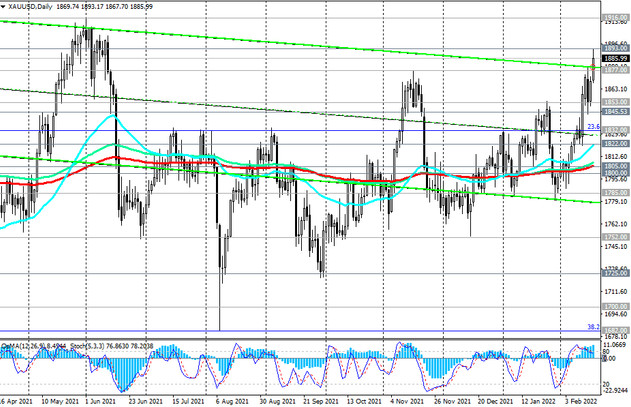"If, contrary to expectations, inflation does not slow down, it would be advisable for the Committee (on open market operations) to remove stimulus measures faster than expected", the minutes of the central bank meeting, released on Wednesday, said.
Nothing new was said in the minutes regarding the prospects for the Fed's monetary policy. On the contrary, they weakened expectations of a more aggressive tightening of the Fed's policy. After last week the US Department of Labor reported another increase in consumer inflation in the country (the consumer price index (CPI) in January rose by +0.6% (+7.5% in annual terms) after rising by +7.0% in December), talk has intensified that Fed officials may raise the interest rate at the March meeting by 50 basis points at once. Some market participants and economists even assumed that this year the Fed's interest rate would be raised another 5-7 times.
However, the minutes of the Open Market Committee meeting released on Wednesday do not confirm this: they only reiterate that decisions to tighten policy will be considered from meeting to meeting.
Market participants were probably so disappointed with the neutral FOMC protocols that they practically ignored the strong macroeconomic statistics released on Wednesday from the US. Thus, retail sales showed a steady growth in January by +3.8% (against the forecast of +2.0% and after a decrease of -2.5% in December). At the same time, industrial production increased by +1.4% (against the forecast of +0.4% and after a decline of -0.1% in December).
As a result of yesterday's trading day, the dollar weakened, and the DXY dollar index fell to 95.70.
At the time of publication of this article, DXY futures are traded near the 95.86 mark, however, there is no strong positive momentum in the dollar for further strengthening yet. Perhaps the reason for growth will appear today, when at 13:30 (GMT) the weekly statistics on the number of applications for unemployment benefits in the US for the week of February 11 will be released.
It is expected that it will indicate a decrease in the number of initial applications for unemployment benefits to 219 thousand from 223 thousand, 239 thousand, 261 thousand, 290 thousand in previous reporting periods. One way or another, this is still a low number of applications for unemployment. It remains at the lowest level for several decades - about 200 thousand. This is a positive factor for the dollar, after it became clear from the report of the US Department of Labor that unemployment in the country is at the minimum pandemic and multi-year level of 4.0%.
Meanwhile, the weakening of expectations of a more aggressive tightening of the Fed's monetary policy (after the protocols published yesterday from the January meeting) contribute to the growth of gold quotes. Thus, the XAU/USD pair reached a new 8-month high of 1893.00 today.

Gold quotes are extremely sensitive to changes in the monetary policy of the world's leading central banks, especially the Fed. When it tightens, the quotes of the national currency (under normal conditions), as a rule, grow, while the price of gold falls.
However, as we can see from the long-term charts, its price is not going to fall. Gold does not generate investment income, but is a popular defensive asset, especially in the face of rising inflation. And if the Fed fails to contain rising inflation, it will make it more difficult for the Fed to keep the balance between economic growth and the monetary tightening cycle, and this, in turn, could hurt the dollar. According to analysts of the gold market, the dynamics of its prices will depend on "whether investors' fears about inflation will intensify and whether interest rates will rise faster than expected".
But as we can see from the rising prices for gold, the conditional “scale” is tilting in favor of buyers of this precious metal, which also receives support from the ongoing tensions between Russia and Ukraine.





